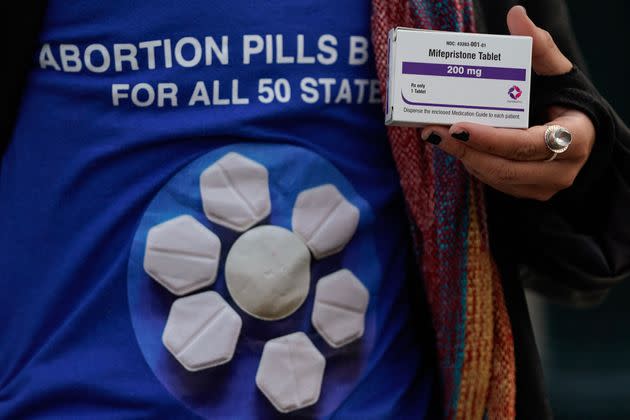The Abortion Pill’s Supreme Court ‘Victory’ Is Not What It Seems. Here’s What’s Next.

When the U.S. Supreme Court issued its unanimous decision in Alliance v. FDA last week, it handed down a little victory for reproductive freedom by tossing a suit brought by far-right extremists who hoped to entirely block federal approval of mifepristone.
They failed. For now.
Abortion pills remain available and can be dispensed via telemedicine through providers like Hey Jane, and that’s something to celebrate. Telemedicine now accounts for 1 in 6 abortions in the U.S., and abortion care by phone, video and mail has become the most viable form of access for much of the country. We are glad the Supreme Court did not let the Alliance plaintiffs get in the way of that access, but this week’s shallow win is not what it seems.
This frivolous case never should have gotten as far as it did. For decades, we have known that mifepristone is incredibly effective and safe, having one of the lowest complication rates of any medication on the market. Since this litigation began in late 2022, it has been successful only in its efforts to sow fear and confusion, delay access to essential health care and distract us from the ongoing threats to our reproductive rights, which have escalated since Roe v. Wade was dismantled in the Dobbs v. Jackson Women’s Health Organization decision in June 2022.
What the Supreme Court unanimously decided last week is obvious. The plaintiffs ― four anti-abortion medical associations and several doctors actively opposed to abortion rights who formed the Alliance for Hippocratic Medicine in August 2022 ― have no standing to challenge the Food and Drug Administration’s decisions based solely on their ideological beliefs. This shouldn’t have made it up to the Supreme Court, and we should all be concerned that seven Republican-appointed lower court judges decided otherwise with complete disregard for the law.
But last week’s “victory” is not what it seems for another reason as well: It leaves open the door for other plaintiffs to continue ushering the baseless claims against mifepristone through the courts. The justices wrote that “it is not clear that no one else would have standing to challenge FDA’s relaxed regulation of mifepristone,” despite being on notice of equally hollow and insincere plaintiffs waiting in the wings.
Idaho, Missouri and Kansas are trying to inject their legal standing into the case by arguing that they too will be burdened by the possibility of increased emergency room visits. The Northern District of Texas had allowed the states to intervene in January, and even though the Supreme Court rejected their attempt to join the preliminary injunction appeal that was just decided, the high court did not put an end to the states’ intervention. Their grievances are even less applicable than those of the original plaintiffs.
Idaho is arguing before the Supreme Court that it is not required under the Emergency Medical Treatment and Active Labor Act (EMTALA) to provide abortion-related care in emergency rooms. In Missouri, two hospitals are being investigated for EMTALA violations for denying abortion-related care in emergency rooms. These states are simultaneously denying abortion care in emergency rooms while claiming they will be burdened by the possibility of more emergency room visits. This hypocritical position is alarming, and these plaintiffs, like the original ones, are singularly aimed at eliminating the agency, capacity, and fundamental rights of patients to make their own health care decisions.
The intervening states’ complaint seeks to stop mifepristone from being distributed by invoking a 151-year-old ghost law called the Comstock Act. The Comstock Act was enacted in 1873 as an “anti-vice” law, and it was historically used to persecute and prosecute individuals who distributed things or information intended for contraception, abortion or other “indecent” or “obscene” purposes. The Comstock Act has always been interpreted by courts to apply only to unlawful distribution, not lawfully prescribed, products. This interpretation has been acknowledged by all branches of government. The notion that the 151-year-old Comstock Act could suddenly be enforced in the context of lawful abortions is wrong and has no basis in law or history. Yet we’ve already heard Justices Samuel Alito’s and Clarence Thomas’ attempts to legitimize such a view during oral argument in Alliance v. FDA.
Comstock revivalists believe they have found a way to turn back time to when women were disenfranchised, and they will not stop at mifepristone. Thomas’ concurrence in Dobbs invited constitutional challenges to the right to contraception, and the fringe idea that frozen embryos have rights is percolating up through state courts. It’s not just the courts that should be of concern: Over the past two weeks, Republicans in the Senate blocked protections for contraception and in vitro fertilization (IVF) while claiming that these forms of health care are not at risk ― just as they did with abortion rights before Dobbs. And if an anti-abortion candidate wins the presidency in November, Project 2025, the Heritage Foundation’s policy road map, indicates there will be attempts to enforce the Comstock Act in complete disregard of our constitutional rights and well over a century of precedents.
If we want a true, long-lasting victory for medication abortion access — and to put an end to baseless litigation threats against it — we need Congress to repeal the Comstock Act. To do that, we need to elect more new members of Congress who are vocal in their support of abortion access. Otherwise, the Comstock revivalists that have risen up post-Dobbs will continue fearmongering their way through the courts.
We cannot become complacent with a shallow and illusory victory. Far-right extremists are tireless in their blatantly misogynistic attempts to take away our bodily autonomy. Luckily, the people are on our side. And last week, so was every single member of the Supreme Court. While we celebrate that, let’s channel our collective power to truly protect and expand reproductive rights for all.

